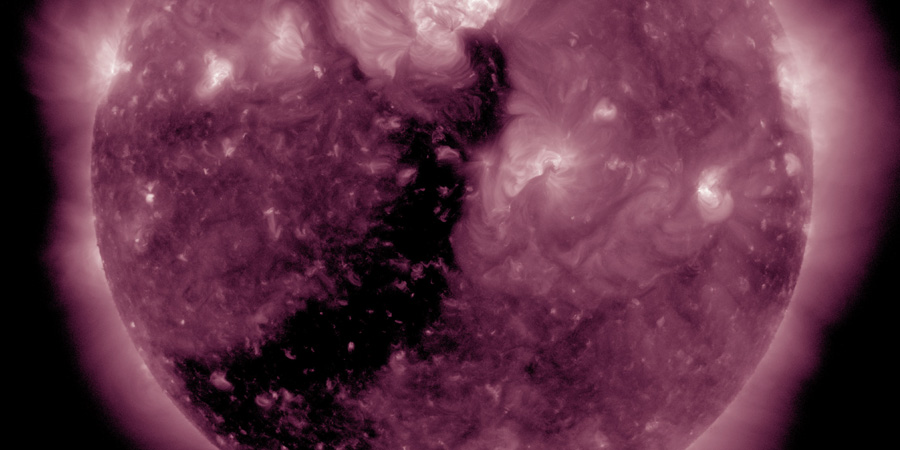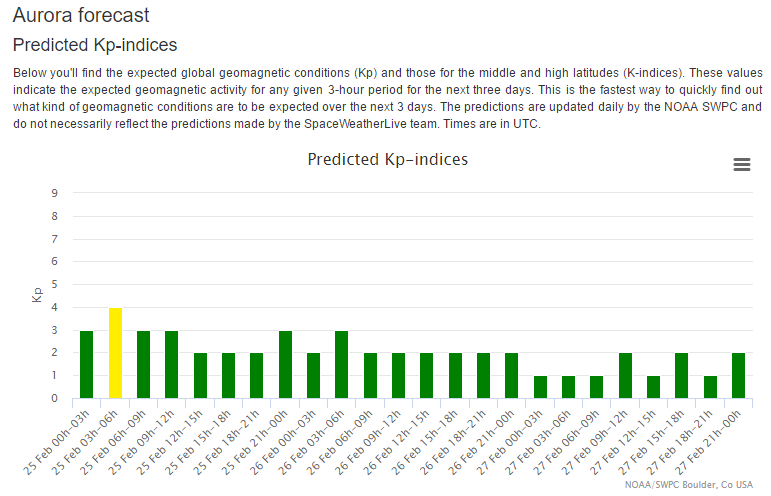Coronal hole, Aurora forecast page
Saturday, 25 February 2017 22:04 UTC

Solar activity is very low today and expected to remain so in the foreseeable future as no sunspot regions on the earth-facing side of the solar disk are complex enough to produce C, M or X-class solar flares. Sunspot region 2638 did gave us a few C-class solar flares during the past few days but it is not a sunspot region to get really excited about. That means we have to shift our attention (like we've been doing for quite some time now) to another solar feature that we've all become very familiar with: coronal holes. Today we have such a coronal hole facing our planet and it is now sending an enhanced solar wind stream towards our planet that is expected to arrive within the next 48 to 72 hours.
A coronal hole is facing Earth. Enhanced solar wind could arrive in ~3 days - Follow live on https://t.co/T1Jkf6i4Cb pic.twitter.com/FNVIV8bRkr
— SpaceWeatherLive (@_SpaceWeather_) February 25, 2017
It is a trans-equatorial extension of the southern hemisphere polar coronal hole that is facing our planet today. This coronal hole is a familiar solar feature as it has been around for months, surviving multiple solar rotations. If we compare the current coronal hole with how it looked like during the previous solar rotation, we see it has shrunk a bit in size. It remains a fairly large coronal hole so we should still see some decent geomagnetic activity from it. In fact, it did manage to bring us multiple 3-hour periods where we reached the minor G1 geomagnetic storm threshold during the previous rotation and there is absolutely reason to believe that this could happen again in the coming days. The solar wind stream is expected to arrive in about 48 to 72 hours from now so we issue a minor G1 geomagnetic storm watch for 28 February 2017. Be sure to follow us on Facebook for additional updates and follow us on Twitter for our space weather alerts!
Aurora forecast page
For those of you who haven't noticed yet: a little while ago, we changed the aurora forecast page. The predicted 3-hour Kp-indices and the predicted 3-hour K-indices for the high and middle latitudes are now displayed as an interactive graph.
The Wang-Sheeley-Arge Model got axed and instead we opted to display the easier to understand long term Kp-forecast from the NOAA SWPC that gives a rough overview for the expected activity for the next 27 days. While space weather is very hard to forecast so far in advance, it does give as a good idea when reliable recurrent solar features like coronal hole solar wind streams are set to return.
Go check it out here!

Thank you for reading this article! Did you have any trouble with the technical terms used in this article? Our help section is the place to be where you can find in-depth articles, a FAQ and a list with common abbreviations. Still puzzled? Just post on our forum where we will help you the best we can!
Latest news
Latest forum messages
Support SpaceWeatherLive.com!
A lot of people come to SpaceWeatherLive to follow the Sun's activity or if there is aurora to be seen, but with more traffic comes higher server costs. Consider a donation if you enjoy SpaceWeatherLive so we can keep the website online!

Space weather facts
| Last X-flare | 2024/03/28 | X1.1 |
| Last M-flare | 2024/04/19 | M1.0 |
| Last geomagnetic storm | 2024/04/19 | Kp7 (G3) |
| Spotless days | |
|---|---|
| Last spotless day | 2022/06/08 |
| Monthly mean Sunspot Number | |
|---|---|
| March 2024 | 104.9 -19.8 |


